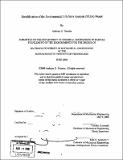Simplification of the Environmental Life Style Analysis (ELSA) model
Author(s)
Teixeira, Anthony D. (Anthony Daigo)
DownloadFull printable version (20.23Mb)
Alternative title
Simplification of the ELSA model
Other Contributors
Massachusetts Institute of Technology. Dept. of Mechanical Engineering.
Advisor
Timothy Gutowski.
Terms of use
Metadata
Show full item recordAbstract
Accurately determining the environmental impacts of specific lifestyles is a critical part of moving to reduce those impacts. However, this process is often complicated and tedious. This study strives to simplify that process by improving upon the Environmental Life Style Analysis (ELSA) model put forth by Gutowski et al. To accomplish this goal, data on the expenditures, divided between eight categories such as transportation or taxes/government services, of 24 different life styles was collected and analyzed. First, a quantity called the impact intensity, defined as the impact per dollar of expenditure, was calculated for each life style in each category. After being deflated to 1997 values, which is required by the ELSA model, these values were then averaged over each of the eight categories to correlate spending in a specific category to impact. This allowed the simplification of the model into a simple eight input version. When this model was tested using values of average expenditure for 1997, it was found to accurately calculate CO2 emissions. While the energy calculations were not particularly accurate, this is a significant step forwards. In addition, the model was able to calculate impacts for a very minimal life style, in this case a homeless man. Data pertaining to the homeless man's expenditures provided insight into the basic environmental impacts caused simply by surviving as a resident of the United States. Although more work needs to be done on this model, this study made strides forward and showed that there is significant potential for this model as a simple but accurate environmental impact calculator.
Description
Thesis (S.B.)--Massachusetts Institute of Technology, Dept. of Mechanical Engineering, 2008. Includes bibliographical references (p. 26).
Date issued
2008Department
Massachusetts Institute of Technology. Department of Mechanical EngineeringPublisher
Massachusetts Institute of Technology
Keywords
Mechanical Engineering.